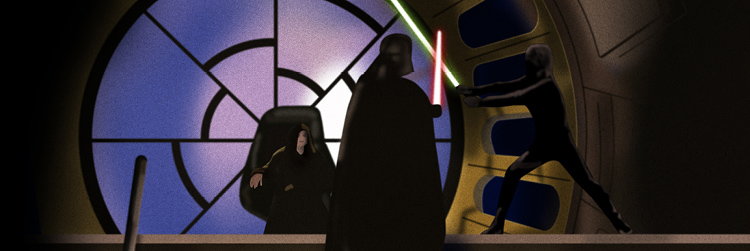When the next Star Wars movie comes out, go to a showing and talk to 20 people standing in line. You’ll hear 20 different stories about the first time they saw the movies — one a 12-year-old with his brother, another a 7-year-old at the cinema for the first time, another a ’90s kid watching The Empire Strikes Back with her dad.
After watching the movie, Jones immediately planned on writing a book about Star Wars, though he says his first few attempts as a 5-year-old didn’t turn out as well as they did much later, when in 2005 he released his book Finding God in a Galaxy Far, Far Away.2 The creative impulse Jones felt after watching Star Wars is a common one. If you hit the midnight showing Dec. 18 for The Force Awakens, the newest installment directed by J.J. Abrams (a fanboy himself who was 11 when the original Star Wars released in 1977), you’ll probably see grown men in Boba Fett costumes and grown women sporting Princess Leia’s iconic hair buns. Many of them have tried their hand at fanfiction, homemade films, music, even personal re-edits of the original films.
 Star Wars not only cultivates obsessive followers but also invites them to inhabit the fictional world for themselves, engendering a rich and diverse expanded universe populated by passionate, talented fans. The kids deeply affected by Star Wars become adults who make their own versions. For Jones and countless others, watching the films for the first time was, in the words of sage Obi-Wan Kenobi, their “first step into a larger world.” And the truth is, Star Wars wasn’t just a fun movie, but stoked the embers of a spiritual awareness, a hunger for the divine and transcendent.
Star Wars not only cultivates obsessive followers but also invites them to inhabit the fictional world for themselves, engendering a rich and diverse expanded universe populated by passionate, talented fans. The kids deeply affected by Star Wars become adults who make their own versions. For Jones and countless others, watching the films for the first time was, in the words of sage Obi-Wan Kenobi, their “first step into a larger world.” And the truth is, Star Wars wasn’t just a fun movie, but stoked the embers of a spiritual awareness, a hunger for the divine and transcendent.
“We can’t escape our longing for some sort of spiritual reality,” Jones said.
Jones avoids attributing explicit Christian themes to the world of Star Wars, which features a more vague spirituality than anything like orthodoxy. The “Force,” the central religious element in the films, is a mystical energy field that unites the universe. Spirituality in Star Wars is being in tune with one’s emotions, transcending the physical world into a zen-like state of mental emptiness and sometimes a near-Gnostic focus on the no-material realm. “Luminous beings are we,” croaks the Jedi Master Yoda, pinching hero Luke Skywalker’s arm. “Not this crude matter!” The Force takes two forms, the “Light Side” and the “Dark Side,” which are like two sides of the same coin, the yin-yang in eternal balance.
Inspiration for Force emerged from Eastern mysticism, and correlations between the Star Wars meta-narrative and the biblical storyline can largely be traced to scholar Joseph Campbell’s comparative mythology — particularly his theory of “monomyth,” which argues all religious myths emerge from a single shared narrative. Campbell’s 1949 book, The Hero With A Thousand Faces, was particularly influential on Star Wars, and Campbell is said to have called Lucas “the best student I ever had.” Christians should then be careful not to read too much continuity between Christianity and the mythology of Star Wars.
“The Force is not God, nor is it supposed to be,” Jones said.
In a 1999 interview with Time magazine, Star Wars creator George Lucas described his goal for the religious character of the Star Wars films. The Force was meant to point to a vague, undefined sense of the supernatural, he said.
“I put the Force into the movie in order to try to awaken a certain kind of spirituality in young people,” Lucas said, “More a belief in God than a belief in any particular religious system. I wanted to make it so that young people would begin to ask questions about the mystery.”
Asking “questions about the mystery” is part of what makes Star Wars potentially harmful (if interpreted too closely with Christian doctrine), but it’s also what makes it resonate. The films uncover a deep hunger for spiritual connection. The moviegoer feels what Luke does in A New Hope as he stares out into the twin sunset of Tatooine to the strains of John Williams’ theme: a sense of purpose beyond the mundane.
“Star Wars tapped into something vast — a whole other world. I think for many people who are now in their 40s, it was that first glimpse of a bigger story,” Jones said. “It awakens a sense of nostalgia and a recognition of how easily we have become jaded, separated from a sense of the mysterious. It also reveals a hunger for deep, emotional and spiritual connection, and the truth is, Star Wars can’t satisfy that. It’s a temporary, passing emotional, reaction with no lasting reality beneath it.”
This mystery is also central to what occasionally makes Star Wars bad, particularly in the prequel trilogy, which among many fans is as reviled nearly as much as the original trilogy is beloved. In the original films, the Jedi are those sensitive to the all-knowing Force, and becoming a Jedi seems more like a kind of learned skill, a reward for the wise. The original movies portray the Jedi as pious, well-trained, deeply spiritual participants in a larger mystery. But the prequels introduce “midi-chlorians,” biological organisms which populate cells. Jedi are those who have a high concentration of these organisms — an exceptional “midi-chlorian count,”3 rendering them something more like the mutants in X-Men: genetic marvels who just won the DNA lottery. Jones can’t help but draw a connection to philosophy.
“Once the Force becomes a quantifiable entity, the mystery no longer exists. They tried to explain the mystery in the prequels,” Jones said. “The originals tapped into an almost premodern mindset; the prequels are modernistic to the core — everything has to be quantified and explained and exposited. There’s no room left for mystery.”
Yet there’s something at the heart of Star Wars jarringly out of step with Eastern religion. The iconic antagonist, Darth Vader,4 spends two movies choking subordinate officers to death and coldly plotting horrible things for heroes Luke, Leia, and Han Solo. He represents the heart of darkness. In the third movie, Return of the Jedi, we learn that Vader is actually Anakin Skywalker, a once-honorable Jedi who turned to the “Dark Side” and the estranged father5 of Luke.
In Jedi, Vader is portrayed sympathetically as the errand boy of Emperor Palpatine, who tempted the young Anakin and converted him to the Dark Side. When the Emperor tries the same thing on the younger Skywalker, it’s because of Luke’s steadfast resistance of temptation from the evil Palpatine that at the climactic moment of the saga, Vader returns to the Light Side and dies to protect his son from the Emperor’s wrath. Luke succeeded where his father failed.6 This redemption is uniquely Christian.
“It is not simply karma — what goes around comes around. It’s nothing like that,” said Jones. “The spirituality in Star Wars is Eastern, but set in a storyline that would be impossible apart from a Judeo-Christian perspective. You have key themes of someone repenting and receiving grace. You have the idea of sacrifice on behalf of another person and redemption — those have been borrowed from a Judeo-Christian worldview. It would be impossible, in a purely Eastern worldview, to be thinking in terms of sacrifice, redemption, and a breaking of the cycle by means of repentance.”
Films are by nature expositional. They present truth claims about reality and suggest narratives which shape how we see ourselves. Some stories are broader or more philosophically compelling than others. The Lord of the Rings and Star Wars recommend comprehensive metanarratives that speak to the cosmic struggle between good and evil. 2001: A Space Odyssey or Tree of Life offer thoughtful explorations of the human experience. Films like Toy Story or The Avengers have smaller aims, but are no less effective at promoting a worldview.
Jones recommends Christians ask two questions of movies: “What lie is this movie trying to tell us?” and “What truths does this movie tell us in spite of itself?” This sort of engagement is not only good for believers’ own sake, but also for the church’s witness. Douglas Blount, professor of Christian philosophy and ethics at Southern Seminary, says how Christians interpret movies contributes to what the world thinks of Christians.
“We live in a culture that is so incredibly media-saturated that if we don’t learn to read media well, we will in many ways lose any credibility we have in speaking to the culture,” he said.
Films are perhaps the main formative element of American culture, so Christians need to do more than just discern a film’s content. They need to engage movies “on their own terms,” as Blount says, identifying the fundamental worldview of the film and juxtaposing it with the Christian metanarrative.
For Jones, interpreting Star Wars starts by recognizing the natural, insufficient impulse toward the spiritual. While the Force is only immanent (present, attainable), Jones says, the Christian God is both immanent and transcendent, and what he offers isn’t mind control and fancy superpowers.
Star Wars can point us to our need for a divine being, and for many, it inspires awareness of the supernatural. In an increasingly non-religious culture, that counts for something. The movies make one aware of the beauty of the cosmos — big, expansive, awe-inspiring, even in galaxies far, far away. Jones points to Calvin’s sensus divinitatus — an awe that apart from regeneration drives one toward idolatry, but with the gospel drives one toward worship of the Creator.
“A thriving sense of awe becomes the fuel of our worship,” Jones said. “Awe doesn’t lead us to the gospel, but it does lead us toward a sense of wonder, and that’s healthy. It turns us toward a greater story.”
So when you slide into your seat this month for the newest installment of Star Wars, the effect might turn out to be, well, more powerful than you could possibly imagine.
NOTES
1 Astute fans will notice that one of the posters reads Revenge of the Jedi, the initial title for the final installment of the original trilogy, released in 1983 (it was changed to Return of the Jedi during production).
2 Random House is re-releasing Finding God in a Galaxy Far, Far Away in December to coincide with the new movie’s release.
3 This is an actual thing said in the prequels.
4 Who would have known he’d set a precedent for big baddies, like Bane in The Dark Knight Rises and Immortan Joe of Mad Max: Fury Road (not to mention the apparent antagonist of the new Star Wars film, Kylo Ren), in need of a permanent CPAP?
5 (Spoiler alert, but not really since this movie is almost 40 years old and the statute of limitations against spoiling it has long passed).
6 In his book Introducing Paul, New Testament scholar Michael F. Bird uses the Anakin-Luke dynamic to illustrate Paul’s theological relationship between Adam and Christ in Romans 5. Through an act of faithfulness, Luke/Christ redeems Anakin/Adam.




